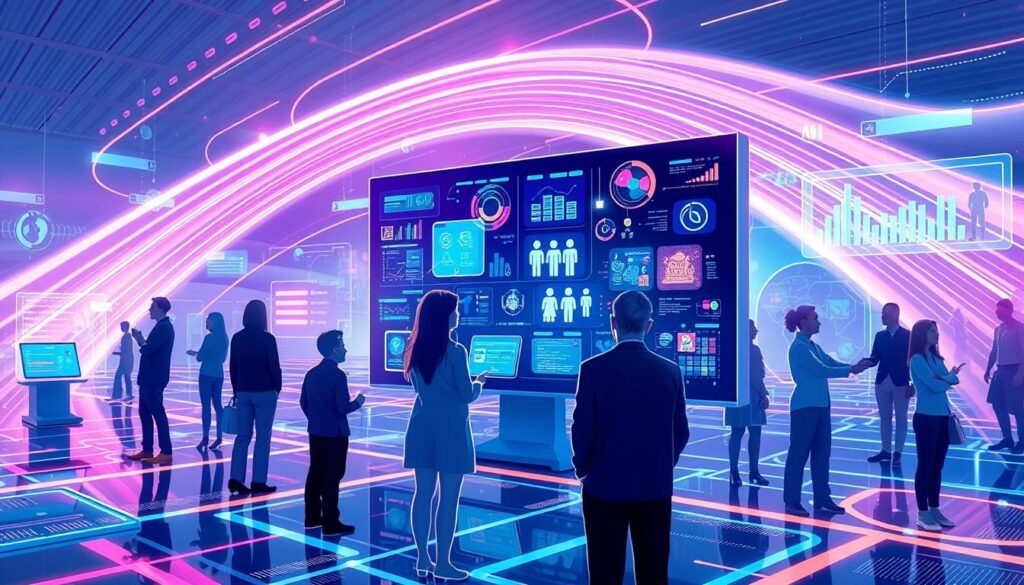In today’s competitive world, automated customer engagement strategies are key for businesses. They help turn prospects into loyal customers and keep them happy after buying. Companies should use a customer engagement automation platform. This platform allows for immediate feedback and meets consumer demands fast.
Statistics show that better customer engagement can lead to a 22% rise in cross-sell income. There could also be a 38% increase in upsell income. With a customer-focused approach, businesses can greatly improve their brand’s visibility and income. Also, since 86% of buyers research online before purchasing, trust is incredibly important. This trust helps brands grow and keeps customers coming back.
Think about using a strategy that builds on this trust. It could make order sizes jump from 5% to 85%, giving a great return on investment. By adopting strong automated customer engagement strategies on a good platform, companies lead in customer experience.
Key Takeaways
- Automation can lead to significant revenue increases through upselling and cross-selling.
- Customer trust is paramount, potentially elevating expenditure with favored brands by 23%.
- Inconsistencies exist between executive and customer perceptions of loyalty—automation can help bridge this gap.
- Active engagement reduces churn rates and boosts customer retention.
- Unified platforms that incorporate AI, such as chatbots, personalize the customer journey.
- Reward programs and interactive events can substantially elevate customer loyalty.
- Innovative gamification strategies make onboarding and engagement more dynamic.
Understanding Automated Customer Engagement Strategies
In today’s digital world, it’s key to use automated systems to make customer interactions better. These strategies help create a customer experience that feels personal. They use tech to give people interactions that they will remember and value.
What Are Automated Engagement Strategies?
Automated engagement means using AI tools to handle customer interactions without needing a person. This way, every customer gets a special experience made just for them. It makes customers feel valued and seen.
Key Benefits of Automation
- Increased Efficiency: Automation cuts down the manual work in talking to customers. This makes things run smoother and saves money, crucial for making customer experiences personal. Learn more here.
- Enhanced Customer Satisfaction: With automation, customers get quick replies any time. This makes them happier with the service.
- Higher Customer Retention: Tools that keep customers coming back help build brand loyalty. This leads to more profits in the long run.
Common Tools and Technologies
Many techs are making automated customer experiences better. For example, Twilio’s platform uses data to send messages that fit what each customer likes. CRM systems and automated analytics help collect and use customer data well. This data is key for smart decisions and keeping customers interested.
In the end, automating how customers experience a service can really help businesses. It not only keeps conversations with customers consistent but also builds strong, loyal relationships over time.
Effective Communication Channels in Automation
In today’s world, using automated marketing campaigns and automated customer communication is key. Things like email, chat automation, and social media help us talk to customers better. They let us send messages that are personal, timely, and fit the situation.
Email Marketing Automation
Email is still a strong way to reach people. It works even better when you make it personal. For instance, adding someone’s name to the subject line can make them 26% more likely to open it. Marketing Automation Platforms (MAPs) are good for sending lots of emails. They are also great for messages that are personal and relevant. This helps keep customers interested and coming back.
Chatbots and Virtual Assistants
Automation can cut labor costs by over 30%. Chatbots and virtual assistants help a lot with this. They give fast and interactive service. This is like having someone help you in a store, but it’s online. It’s especially useful in retail, telecoms, and hospitality. AI chatbots can talk to users in a personal way. They can also collect info that helps with future ads. They even work when the business is closed.
Social Media Engagement
Social media is important for talking to customers as things happen. It helps businesses get closer to people. They can share things customers like and answer their questions quickly. By using automation, companies can plan posts and check on how they’re doing. Keeping active on social media makes people feel more connected to the brand. This is good for keeping customers for a long time.

Automation helps businesses keep in touch while also saving money. It does things like send emails, talk to people through chatbots, and manage social media. This makes sure customers have a good experience everywhere they interact with the brand. It helps draw in new customers and keep the ones they already have.
But, it’s important for businesses to always check on how things are going. They need to use what they learn from talking to customers. This makes sure the tech keeps helping. It makes customers happy, cuts costs, and makes things run better.
Personalization Techniques in Automated Strategies
Using personalized customer experience automation puts businesses ahead. It makes them stand out in a crowded market. Techniques like audience segmentation, dynamic content in marketing, and using behavioral data can boost automated marketing strategies.
Segmenting Your Audience
Segmenting your audience is key for a personalized customer experience. This means grouping potential customers by things they have in common. These could be demographics, purchase history, or how they behave online. By doing this, businesses make their content feel more customized and relevant.
Segmented campaigns lead to better marketing results. They get more interaction and higher conversion rates. This shows how effective personalization can be.
Dynamic Content Creation
Dynamic content in marketing lets businesses show content that changes based on user actions. This could be through personalized emails, website content, or tailored ads. The goal is to send messages that feel personal to each customer. Today’s customers expect this level of responsiveness.
Data shows that dynamic emails do better than generic ones. They have higher open rates and generate more revenue. This highlights a clear preference for marketing that adapts to the customer.
Utilizing Behavioral Data
Using behavioral data makes personalized marketing more effective. This approach looks at how certain behaviors connect to goals like sales conversion or email responses. By tailoring interactions based on this data, marketing aligns with what customers expect and prefer. This enhances the customer journey and encourages loyalty to the brand.
| Feature | Impact | Improvement |
|---|---|---|
| User Segmentation | Higher engagement | Converts passive audiences into active participants |
| Behavioral Data Usage | Refined targeting | Improves campaign success rates |
| Dynamic Content | Increased personal relevance | Boosts customer satisfaction and retention |
Adding personalized customer experience automation to marketing strategies meets customer expectations. It improves how customers interact with the brand online. Using dynamic content in marketing greatly boosts customer engagement. This sets the foundation for ongoing business growth and strong customer loyalty.
Measuring Success in Customer Engagement
In today’s market, the way businesses connect with customers matters a lot. They use different ways to see how well they are doing. By paying attention to Key Performance Indicators (KPIs), looking at what customers say, and changing things based on what they learn, businesses can get better results.
Key Performance Indicators (KPIs)
KPIs are vital for understanding how customers interact with a brand. Metrics like the Net Promoter Score (NPS) show if customers would suggest the brand to others. Then there’s Customer Lifetime Value (CLV), which shows how valuable a customer is over time. These measures help see how engagement strategies affect loyalty and money made.
Analyzing Customer Feedback
Feedback from customers is key in making smart business choices. Surveys like the Customer Satisfaction (CSAT) score share how happy customers are right now. Meanwhile, the Customer Effort Score (CES) checks how easy it is for customers to solve problems. Using this info, companies can make changes that really please or help customers.

Adjusting Strategies Based on Data
Changing engagement strategies based on current data is crucial. For example, higher NPS or CSAT scores can mean more money and fewer lost customers. By acting on this data, like updating technology or making processes better, companies can keep up with the competition.
Looking at how customers interact and using their feedback is essential. This approach keeps businesses in tune with what customers want. It not only keeps customers happy but also helps the business grow.
Integrating Automation with Your Existing Systems
To fully use a customer engagement automation platform, mix it with your current systems. This is key for better growth, data handling, and personalized customer interactions.
CRM and Automation Integration
First, align automation with your Customer Relationship Management (CRM) systems. This helps in sending targeted, personalized messages to deepen customer ties. Tools like Adobe Commerce and Adobe Marketo Engage offer great personalization that works well with CRMs. This makes every customer interaction count.
Training Your Team on New Technologies
Introducing new tech means changing technically and culturally. It’s crucial to train your team. They need to use these tools well to boost customer happiness. The focus should be on both how to use the tech and why it’s beneficial. This includes better efficiency and more consistent customer experiences.
Overcoming Possible Challenges
Bringing automation into current systems offers many perks but also presents hurdles like data gaps and mismatched customer profiles. Tackling these problems needs a combined data management effort and a solid plan to move data to new systems. Chatbots, for instance, can make handling customer interactions easier. They speed up replies and boost service quality.
In sum, correctly mixing automation tech in customer management improves work processes and customer engagement. This leads to keeping more customers and offering superior service.
Future Trends in Automated Customer Engagement
Looking ahead, AI and machine learning are changing how we engage with customers. These aren’t just trends; they are becoming the backbone of future customer interactions. By 2026, 30% of new apps will use AI to make user interfaces that adapt and personalize, jumping from today’s under 5%.
This move ushers in an era of AI-based customer service. It’s evolving from a generic system to one that’s tailored for each person. Customer service will shift from a one-size-fits-all approach to one that’s personalized.
AI and Machine Learning Innovations
The AI market is expected to reach $407 billion by 2027. Companies are gearing up to use AI for deeper insights into what customers want. They’re using data from the 2024 Global Customer Engagement Review to better understand and predict consumer preferences.
AI is also enhancing online shopping and smart assistants, making experiences more personal. This approach meets the needs of the 29% of consumers who like emotion tracking for tailored marketing.
The Rise of Omnichannel Strategies
Omnichannel approaches are changing how brands interact with customers. Now, 43.4% of US consumers can buy directly on social media, without leaving the platform. This shows a high demand for smooth, integrated shopping experiences.
Brands are working to keep their messaging consistent across all channels. They aim to create a unified story. This strategy connects with the 84% of people who value experience as much as products or services.
Enhancing Customer Experience through Automation
Improving customer service with automation is becoming essential. 80% of customers prefer brands that personalize their experience. In the coming years, we’ll see more automation in customer interactions.
This automation will make engagement more efficient and the customer journey stronger. It aims to make every interaction personalized. This boosts customer loyalty and sets new standards for businesses to compete.



